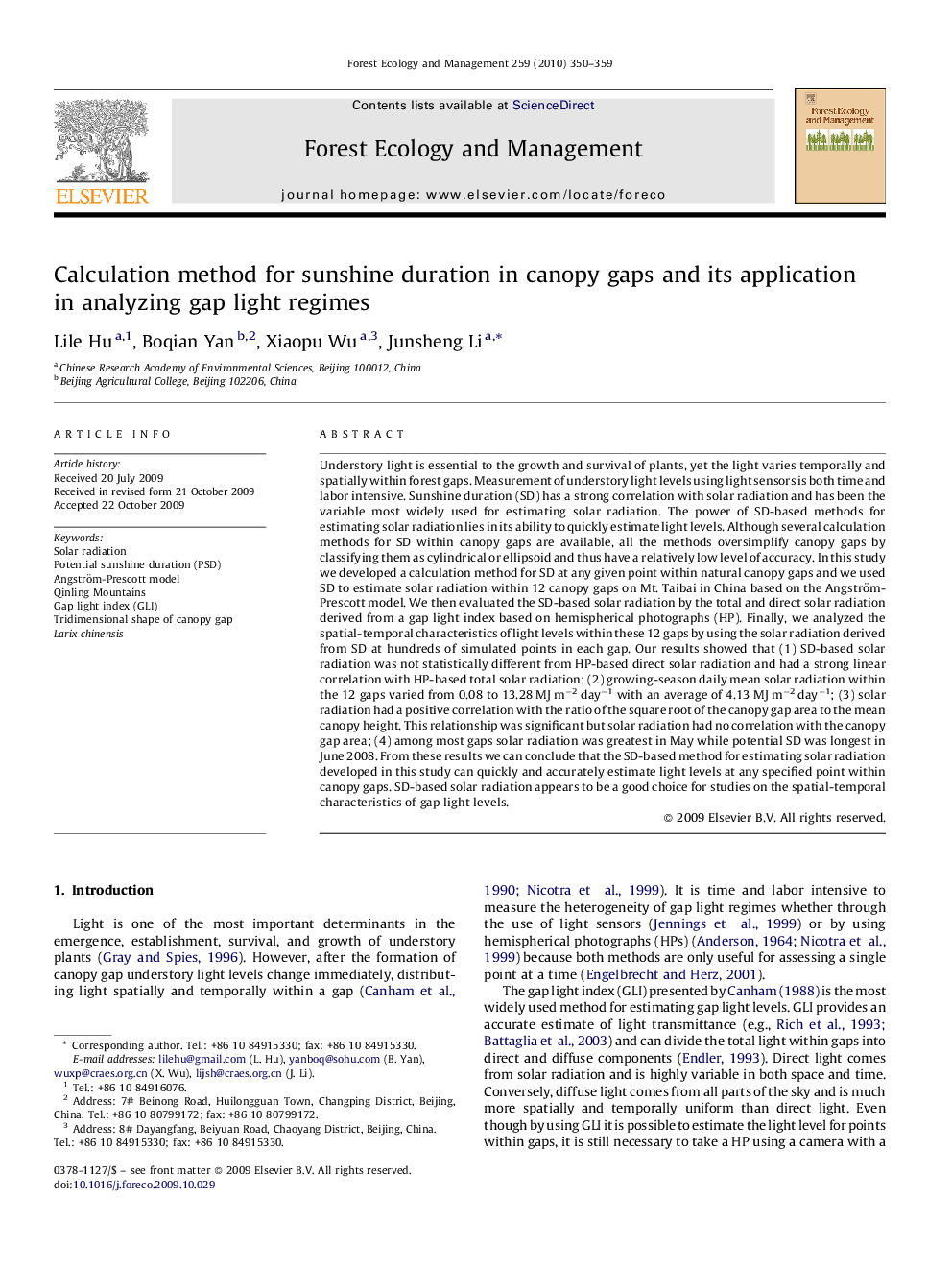| کد مقاله | کد نشریه | سال انتشار | مقاله انگلیسی | نسخه تمام متن |
|---|---|---|---|---|
| 10250562 | 159322 | 2010 | 10 صفحه PDF | دانلود رایگان |
عنوان انگلیسی مقاله ISI
Calculation method for sunshine duration in canopy gaps and its application in analyzing gap light regimes
دانلود مقاله + سفارش ترجمه
دانلود مقاله ISI انگلیسی
رایگان برای ایرانیان
موضوعات مرتبط
علوم زیستی و بیوفناوری
علوم کشاورزی و بیولوژیک
بوم شناسی، تکامل، رفتار و سامانه شناسی
پیش نمایش صفحه اول مقاله

چکیده انگلیسی
Understory light is essential to the growth and survival of plants, yet the light varies temporally and spatially within forest gaps. Measurement of understory light levels using light sensors is both time and labor intensive. Sunshine duration (SD) has a strong correlation with solar radiation and has been the variable most widely used for estimating solar radiation. The power of SD-based methods for estimating solar radiation lies in its ability to quickly estimate light levels. Although several calculation methods for SD within canopy gaps are available, all the methods oversimplify canopy gaps by classifying them as cylindrical or ellipsoid and thus have a relatively low level of accuracy. In this study we developed a calculation method for SD at any given point within natural canopy gaps and we used SD to estimate solar radiation within 12 canopy gaps on Mt. Taibai in China based on the Angström-Prescott model. We then evaluated the SD-based solar radiation by the total and direct solar radiation derived from a gap light index based on hemispherical photographs (HP). Finally, we analyzed the spatial-temporal characteristics of light levels within these 12 gaps by using the solar radiation derived from SD at hundreds of simulated points in each gap. Our results showed that (1) SD-based solar radiation was not statistically different from HP-based direct solar radiation and had a strong linear correlation with HP-based total solar radiation; (2) growing-season daily mean solar radiation within the 12 gaps varied from 0.08 to 13.28Â MJÂ mâ2Â dayâ1 with an average of 4.13Â MJÂ mâ2Â dayâ1; (3) solar radiation had a positive correlation with the ratio of the square root of the canopy gap area to the mean canopy height. This relationship was significant but solar radiation had no correlation with the canopy gap area; (4) among most gaps solar radiation was greatest in May while potential SD was longest in June 2008. From these results we can conclude that the SD-based method for estimating solar radiation developed in this study can quickly and accurately estimate light levels at any specified point within canopy gaps. SD-based solar radiation appears to be a good choice for studies on the spatial-temporal characteristics of gap light levels.
ناشر
Database: Elsevier - ScienceDirect (ساینس دایرکت)
Journal: Forest Ecology and Management - Volume 259, Issue 3, 25 January 2010, Pages 350-359
Journal: Forest Ecology and Management - Volume 259, Issue 3, 25 January 2010, Pages 350-359
نویسندگان
Lile Hu, Boqian Yan, Xiaopu Wu, Junsheng Li,